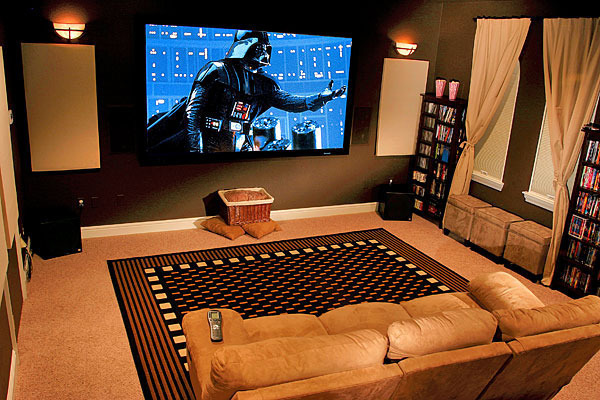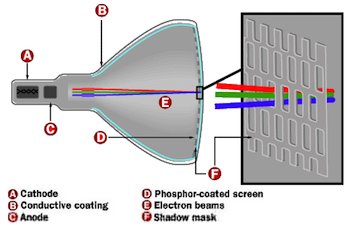The concept of a home theater is excellent if you want to enjoy the cinema experience from the comfort and convenience of your home. If you are looking to build your own home theater, here are some recommendations.
Choose a Room
The size and location of your room will have definite consequences on how and when you enjoy your home theater. For instance, make sure your room is big enough so that you can install a large screen TV, surround sound speakers and furniture for you and your friends to sit comfortably while watching a movie. You should also choose a room that is relatively quiet and as sound proof as possible. If your home theater is right next to your infant’s sleeping room, you might not be able to play your movies loud during the evenings; usually a large room with an insulated distance from bedrooms and living quarters is the best place to house your home theater system.
Choose Your TV
Usually the first consideration you should make is the type and size of the TV set you should have. Most people either choose a large rear projection TV, flat panel LCD or plasma TV. It is also possible to receive digital video signals from a projector. Most people today also choose HDTV technology to compliment their home theater systems, with the same 16:9 aspect ration as a cinema. The majority of flat panel TV’s and projectors can reproduce the superior quality 780p and 1080p resolution formats found in HDTV. They also tend to be very thin, and for home theater set ups most people choose TV’s in sizes over 30 inches.
Choose your Home Theater Receiver
Just as your TV is central to your video, a home theater receiver is the brain of your audio reproduction. Home theater receivers not only provide power to speakers, but control inputs such as CD player, DVD player, turntable, other media devices and in a lot of cases the audio of your TV set. Home theater inputs are considered the brains of your entire home theater set up, because they provide inputs for all your components and speakers, whether they connect via speaker cable, RCA cable, S-Video ports, USB ports, HDMI (High Definition Multimedia Interface), optical ports or other auxiliary ports and interfaces.
Home theaters also digitally process sound in order to create a surround sound environment. Surround sound works with strategically placed speakers around a viewer to envelop them into the action. Some of the surround sound formats available are Dolby Pro logic II, Dolby Digital, DTS, THX Surround and DTS- EX. These surround sound formats allow you to add specific number of speakers usually from 5 to 6 different types of speakers and one sub woofer.
Choose Surround Sound Speakers
Now that you purchased your receiver and understand how much power its amplifier has and the kinds of digital surround sound formats available, you can now choose your surround sound speakers. Home theater receivers either play 5.1 or 6.1 formats. This means that with a 5.1 system you will have 2 separate front channel speakers (front left, front right), 1 center channel speaker, and 2 rear channel speakers (sometimes referred to as surround sound speakers). Also included is the subwoofer. For a 6.1 system, you will have the above sets of speakers, plus the ability to add an extra set of rear speakers (surround sound speakers).
Front Right and Front Left Speakers
These two speakers are possibly the most important. They are powered individually and usually the most powerful. This is where most of the action will take place, where most of your music and sound will emerge. When you are listening to other components such as CD’s or vinyl records, your music will come from these two speakers. If you are going to splurge, splurge on these two speakers, but it is always a good idea to have speakers which are evenly matched throughout your home theater system.
Center Channel Speaker
The center channel speaker is where the majority of the dialogue resonates from. This is an extremely important speaker because it anchors the actor’s speech and dialogue. The center channel speaker sits above or below the TV set and is magnetically shielded to avoid interference.
Surround Sound Speakers
Surround sound speakers (sometimes referred to as rear speakers) are usually placed in the line of the sight with the viewers’ ears or behind the viewer. These speakers help envelop the viewer within the movie soundtrack, so that you can hear sound all around.
Second set of Surround Sound Speakers
If your home theater receiver has a 6.1 hook up, you will have the ability to add a second set of surround sound speakers. In this case, your first set of surround sound speakers will usually be in the line of sight of your ears (on the side of you), the second set of surround sound speakers will be behind you.
Subwoofer
The subwoofer is an extremely important part of your overall sound system. The subwoofer can reproduce extremely low frequency sounds such as explosions, percussion or plain old deep bass. If you want to feel your sound instead of just hear it, it is important that you purchase a subwoofer. The good thing about a subwoofer is that it is omni directional, meaning that it can be located anywhere in the room and will still deliver great low frequency response.
Other Audio and Video Components
Besides your TV set, a home theater receiver and surround sound speakers, you need components to play media to enjoy on your home theater system. These components usually include DVD players, High definition DVD players, CD player, media player (plays data files such as MP3’sand WMA formats) and a turntable.
DVD and High Definition DVD Players
One of the most popular ways to watch movies on your home theater is with DVD media. Today there are three different DVD formats; they are standard DVD’s, HD DVD and Blu Ray. While Blu Ray and HD DVD players are new on the scene, they have the added benefit of playing much higher quality High Definition videos.
CD Players, Multimedia Players and Turntables
Besides video components, you will probably will still want to listen to your collection of favorite CD’s, as well as listen to your new music that is now digital, such as MP3’s and WMA files. For true music connoisseurs there is still the option to listen to your old vinyl albums with new, high quality turntables that you can also hook up to many home theater receivers.
If you are looking for the maximum amount of entertainment options, all of which you can enjoy in the privacy, comfort and convenience of your own home, the above tips should help you with building a home theater system.
Brad Waite is a home theater engineer with Integrity Home Theater.




Jay Taylor
I just built a home theater and I love it. The only thing I did not do was all the electrical and lighting work. Instead, I hired the Sugarland electrician from MisterSparky-Houston to do all the work.